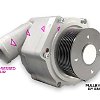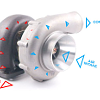Today’s RevZilla version of a tech article is not my usual "why things are" approach, but rather "what is this thing?"
By now, everyone with an internet connection has seen the Kawasaki H2R, one very badass, track-only motorcycle that Kawi says makes "roughly 300 horsepower." Soon, we'll get to see the street-legal version, the Ninja H2. A few things set the H2R apart, but the most important one that is responsible for that headline 300 number is the supercharger attached to the liter-size engine. The H2R gets its huge power from forced induction.
If you’re one of the people wondering what forced induction is, fantastic! I wrote this article especially for you.
Natural aspiration, nature's way of breathing
Let's start with the norm. Unless you ride a rarity, the motorcycle you ride has a naturally aspirated engine. Air (mixed with fuel) is sucked into the combustion chamber as the pistons drop in the cylinders, creating a vacuum.
Forced induction doesn't suck
Forced induction can be done in various ways, but those ways all have one thing in common: air isn't sucked in, it is literally stuffed under pressure into the cylinders. Since normal, garden-variety air is a gas, it is compressible. If pressurized, it becomes possible to shove a larger volume of air (and a correspondingly larger amount of fuel) into the same space (the cylinder) than air at atmospheric pressure. More air and fuel means more energy to burn, which means more power.
The two most frequently seen ways of compressing the air going into the engine are supercharging and turbocharging.


So why don't we see forced induction on motorcycles?
I can't think of a factory supercharged bike before the new H2. Turbo bikes have been done before, though! Recently, Suzuki had one bolted on to the side of its concept Recursion bike. Many folks will also remember the finicky turbo bikes sold in the 1980s, around the same time turbos temporarily caught on in the car world, too. The Suzuki XN85, the Honda CX500TC, the Kawasaki GPZ750 and the Yamaha Seca are examples.
Turbo bikes fell out of favor for a lot of reasons. One was the added complexity and the difficulty of stuffing that plumbing into the small nooks and crannies of a motorcycle engine. Plus, keeping them in top running form was a mixture of art and science for most mechanics, who did not have lots of experience or training with forced induction. The turbo bikes also cost more. For all those reasons, if more power was needed, it was easier to bump up the displacement a little than to add the cost and complexity of forced induction.
So I'll never have a turbo bike?
Actually, changing circumstances may bring forced induction back to the motorcycle world. One reason that forced induction is popping back up as a viable technology is improved engine management. Spark knock and pre-ignition are a constant danger for engines with turbos and supers, but modern ECUs have the processing power to monitor the engine constantly and electronically adjust fuel curves and spark timing to avoid damage.
Ever-improving metallurgy and nearly ubiquitous liquid-cooling help make avoiding knock a little easier than it was 30 years ago. Also, there's another new technology that helps: direct injection. Diesel engines have used forced induction for a very long time because they introduce air and fuel separately, minimizing the problem of pre-ignition. Direct injection allows a gasoline engine to do the same thing.
A greater emphasis on fuel economy could also encourage a return of forced induction. Imagine a lightweight two-fiddy with a turbo, putting out 500cc-level power, for a commuter bike. You’d get good fuel economy most of the time, but still have power on tap for merging onto the Turnpike.
That would be a fun little gas-sipper, wouldn’t it? A forced-induction motorcycle like that wouldn't suck at all.







